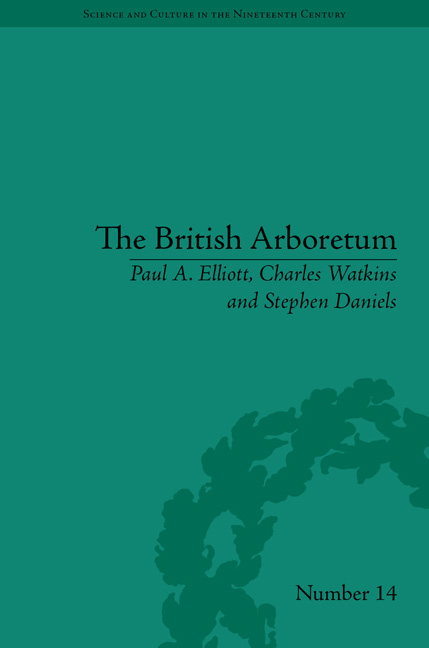Book contents
- Frontmatter
- CONTENTS
- List of Figures
- Preface
- Introduction
- 1 British Tree Cultures in the Nineteenth Century
- 2 Trees and Taxonomy
- 3 British Arboriculture, c. 1800–35
- 4 John Claudius Loudon's Arboretums
- 5 The Botany of the Arboretum Britannicum
- 6 The Derby Arboretum
- 7 Estate Arboretums
- 8 Public Urban Arboretums
- 9 The Transformation of Victorian Public Arboretums
- Conclusion
- Notes
- Works Cited
- Index
8 - Public Urban Arboretums
- Frontmatter
- CONTENTS
- List of Figures
- Preface
- Introduction
- 1 British Tree Cultures in the Nineteenth Century
- 2 Trees and Taxonomy
- 3 British Arboriculture, c. 1800–35
- 4 John Claudius Loudon's Arboretums
- 5 The Botany of the Arboretum Britannicum
- 6 The Derby Arboretum
- 7 Estate Arboretums
- 8 Public Urban Arboretums
- 9 The Transformation of Victorian Public Arboretums
- Conclusion
- Notes
- Works Cited
- Index
Summary
Introduction
The Derby Arboretum and Loudon's publications encouraged the planting of greater varieties of trees and shrubs and the provision of arboretums in public parks and gardens and the formation of public arboretums. Public arboretums were partly inspired by the discourse of rational recreation as expressed by the Select Committee on Public Walks of 1833 and partly intended to ameliorate the problems of urban industrial expansion and to provide a taste of rural pleasures in urban settings. Like Ruskin's intentions for architecture, arboretums were an attempt to restore the ‘loss of fellowship with nature’, to bring a piece of the countryside into towns and provide an opportunity to experience the foreign and exotic. As the Walsall Observer put it after the formation of a local arboretum, the ‘tendency of the age is towards the creation of an artificiality … incompatible with natural and real life’; the park would help ‘restore that balance’ which ‘busy commercial and industrial life has rendered artificial and unnatural’. Arboretums were places for urban refreshment where, as Charles Kinglsey observed of galleries, town dwellers could escape the grim smoky ‘city-world of stone and iron’ by taking country walks and wandering ‘beneath mountain peaks, blushing sunsets … broad woodlands … green meadows … overhanging rocks [and] rushing brooks’. Rational recreational objectives help to explain similarities between arboretums as ‘living museums’ and other nineteenth-century civic institutions such as galleries, museums, libraries and mechanics’ institutions.
- Type
- Chapter
- Information
- The British ArboretumTrees, Science and Culture in the Nineteenth Century, pp. 185 - 210Publisher: Pickering & ChattoFirst published in: 2014



